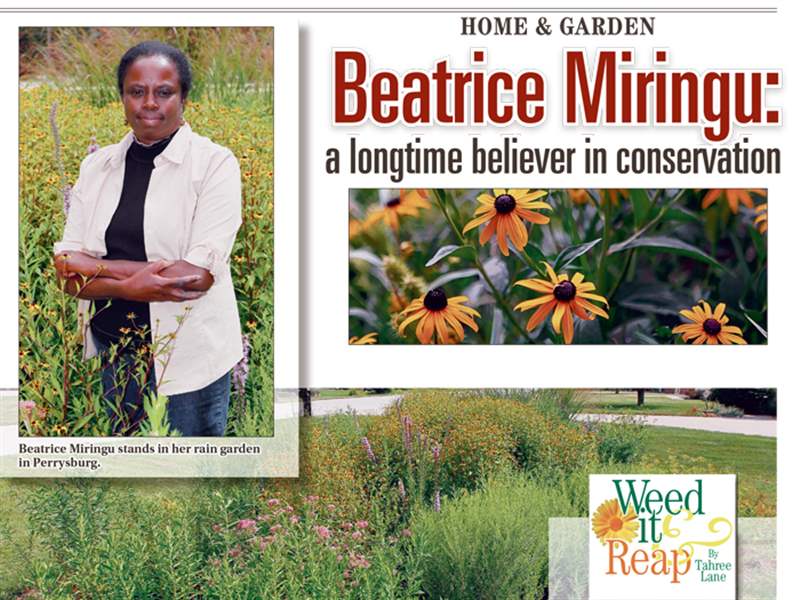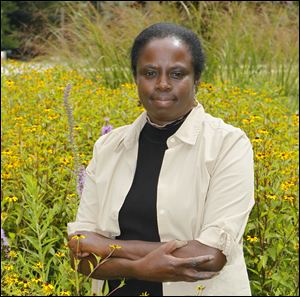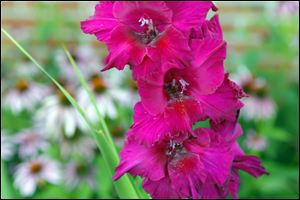
WEED IT AND REAP
Beatrice Miringu: a longtime believer in conservation
Environmental specialist for the City of Toledo lives in Perrysburg
8/20/2013
Weed It And Reap: Beatrice Miringu

Beatrice Miringu in her rain garden at her Perrysburg home.
Name: Beatrice Miringu, senior environmental specialist for the City of Toledo, living in Perrysburg. (Note: There is a demonstration rain garden at the city’s Environmental Services building, 348 S. Erie St., near the Toledo Farmers’ Market.)
PHOTO GALLERY: Beatrice Miringu's rain garden
Garden specs: On nearly one-half acre of clay soil, the vegetable garden is 20-by 10-feet and the rain garden is a kidney-shaped, 250 square feet.
When did you start gardening? As far back as I can remember. I grew up on a plateau, elevation 6,400-feet, in central Kenya not far from Thompson Falls where my parents had some land and a simple farm. We grew almost all the food we needed: kale, kidney and pinto beans, sweet potatoes, cabbage, potatoes, tomatoes. My father died when I was young, and after that, I worked with my mother who loved plants and knew a lot. We took our vegetables to a village market and sold them.
In 1995, when I lived in Nairobi, I had a vegetable garden. And after I bought this house, I put in a vegetable garden in spring, 2010, and a rain garden out front in fall, 2010 with the help of a landscape architect and Naturally Native Nursery. Water for the rain garden drains from 782 square feet of my roof into a downspout, then through a perforated pipe that’s buried 12 inches deep, emptying into the rain garden about 20 feet from the house.
What do you grow? Kale, peppers, squash, oregano, parsley, lettuce, tomatoes, cantaloup, green onions, potatoes, zucchini, sorrel, deer-tongue lettuce, African blue basil (also called opal basil). One peach and two pear trees. The rain garden has native plants that have filled in over three years with asters, dense blazing stars, stiff goldenrod, golden Alexander, little bluestem, beardtongue/penstemon, native iris, native black-eyed susan. I also have native gooseneck, and Siberian sage (not a native).
What’s your favorite plant? In the rain garden, definitely the swamp milkweed. The first time I saw those yellow-striped monarch caterpillars on it, that did it for me. Now I stop by the milkweed to check for caterpillars but haven’t seen any this year. In the veg garden, my favorite is kale because it’s the most-used vegetable in Kenya and reminds me of the food I ate growing up. But I like all the veggies I grow, and most can be used in salads as well as for cooking.
Give us a tip: Have plants that have multiple use or purpose (for example, can be used in salads and soups), low-maintenance plants to reduce weeding and watering (such as native grasses), plants that are magnets for butterflies, insects, and birds. Select plants with an interesting appearance (leaves, colors, shapes.) You’re not trying to be or to beat P. Allen Smith (television garden and design host). Just have fun and enjoy your garden.

Flower in the front of Beatrice Miringu home in Perrysburg.
Hours spent gardening per week: One to two hours, but many more just enjoying the gardens.
Annual expense: Installation of the rain garden was less than $500, but there’s been no cost since then. In fact, the native plants have multiplied so much they need dividing. Initial cost depends on the soil type and the size of the garden, plant selection, and seedling size. You can also obtain some of these, as I did, at plant exchanges and seed swaps. The veg garden costs about $50 to $100 for seedlings. I use grass clippings for water-retaining/weed suppressing mulch.
Challenges: In the rain garden, aggressive, self-propagating plants. In the vegetable garden, weeds, because I do not like using herbicide or insecticides.
I’m proud of: My rain garden and sharing my passion for gardening with my son, Wakanene Kamau, who has an urban garden in Chicago. I’m on the board of the local chapter of Wild Ones (www.wildones.org/chapters/toledo/), and I’ve long been a believer in conservation. In the late 1990s, another scientist and I found on a hill in central Kenya and identified a subspecies of a critically endangered type of palm tree that is often poached and sold [encephalartos tegulaneus subsp. powysii]. I coauthored an article about it in the Journal of East African Natural History (1999).
What I’ve learned gardening: All the plants around my home are low maintenance and a good blend of natives and non-natives.
Contact Tahree Lane at tlane@theblade.com and 419-724-6075.